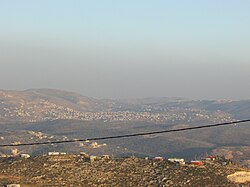Einabus
Municipality type D in Nablus, State of Palestine From Wikipedia, the free encyclopedia
Municipality type D in Nablus, State of Palestine From Wikipedia, the free encyclopedia
Einabus (Arabic: عينابوس) is a Palestinian village in the northern West Bank, located 12 kilometers (7 miles) south of Nablus and a part of the Nablus Governorate. Nearby towns include Huwara and Beita to the east and Jammain to the south.[3]
Einabus | |
|---|---|
| Arabic transcription(s) | |
| • Arabic | عينابوس |
| • Latin | Ainabus (official) 'Aynabus (unofficial) |
 In the front, beneath the telephone cable, is mount 725, an illegal Israeli outpost of Yitzhar. Beneath it, crossed by the telephone cable, is Einabus. Covering most of the farther area is the municipality of Qabalan. Behind the right side of Qabalan is Talfit, and behind it is Qaryut. Behind the middle of Qabalan is Ahijah. | |
Location of Einabus within Palestine | |
| Coordinates: 32°08′48″N 35°14′42″E | |
| Palestine grid | 173/172 |
| State | State of Palestine |
| Governorate | Nablus |
| Government | |
| • Type | Village council (from 1996) |
| • Head of Municipality | Nafez Rashdan |
| Area | |
| • Total | 4,011 dunams (4.0 km2 or 1.5 sq mi) |
| Population (2017)[1] | |
| • Total | 2,891 |
| • Density | 720/km2 (1,900/sq mi) |
| Name meaning | "The spring of Abus"[2] |
‘Einabus is located 8.23 kilometers (5.11 mi) south of Nablus. It is bordered by Huwwara to the east, ‘Urif to the north, ‘Urif and Jamma'in to the west, and Jamma’in and Huwwara to the south.[4]
Tombs dug out of the rocks and ancient cisterns have been found here.[5]
Potsherds from Middle Bronze Age, LB/IA I, Iron Age II, Persian, Hellenistic, Roman and Crusader/Ayyubid era have been found.[6]
The village's old mosque was built during that time and is dedicated to Umar ibn al-Khattab. Until today, olives and figs remain primary sources of income for the residents of Einabus.[3]
The old mosque, Jama al-Arbain, was inspected in 1928 and 1942, and on a column was found inscribed the name Abdallah and the date 625 AH (=1227-1228 CE).[7]
The village was incorporated into the Ottoman Empire in 1517 with all of Palestine, and in 1596 it appeared in the tax registers as being in the Nahiya of Jabal Qubal, part of the Sanjak of Nablus. It had a population of 49 Muslim households. They paid a fixed tax-rate of 33.3% on agricultural products, including wheat, barley, summer crops, olives, and goats or beehives; a total of 5,317 akçe.[8]
In 1838, Edward Robinson noted it on his travels as a village, named Ain Abus.[9] It was noted was a village in the Jurat Merda district, south of Nablus.[10]
In June, 1870, French explorer Victor Guérin found the village to have a spring (after which it was named), and having about 400 inhabitants. Below the village was a valley of olive trees.[11]
In 1870/1871 (1288 AH), an Ottoman census listed the village in the nahiya (sub-district) of Jamma'in al-Thani, subordinate to Nablus.[12]
In 1882, the PEF's Survey of Western Palestine described the village (called Ain Abus) as "a small village conspicuous on a low spur of the mountain, with a spring to the west and olives to the south."[13]
In the 1922 census of Palestine conducted by the British Mandate authorities, 'Ainabus had a population of 227 inhabitants, all Muslims,[14] increasing slightly in the 1931 census to 244, still all Muslim, in a total of 62 houses.[15]
In the 1945 census, the population was 340, all Muslims,[16] with 4,011 dunams (991 acres; 4.011 km2) of land, according to an official land and population survey.[17] Of this, 539 dunams (133 acres; 0.539 km2) were for plantations or irrigated land, 2,107 for cereals,[18] while 29 dunams were built-up (urban) land.[19]
In the wake of the 1948 Arab–Israeli War, and after the 1949 Armistice Agreements, Einabus came under Jordanian rule.
The Jordanian census of 1961 found 524 inhabitants in Einabus.[20]
Since the Six-Day War in 1967, Einabus has been under Israeli occupation.
After the 1995 accords, 85% of the village land was classified as Area B, the remaining 15% as Area C. Israel has confiscated 114 dunums of Ein Abus land for the construction of the Israeli settlement of Yitzhar. Since Yitzhar was established, the villagers of Einabus have been the victims of several violent attacks from the Yitzhar settlers. The Israeli settlers have also stolen crops and damaged Palestinian homes.[21]
As of 2012, Israeli settlers have also taken over land in Area B, in "a combination of unbridled thievery by settlers and impotence on the part of the Israeli authorities."[22]
The village had a population of 1200 in 1987,[3] according to the Palestinian Central Bureau of Statistics, and of 2,891 in 2017.[1]
There are two girls' secondary schools and one for boys. A charity center founded in 1984 contains a kindergarten and a training center for weaving and helps college-bound students that are financially unable to enter college to attend. In addition to the old mosque, Einabus has two modern mosques.[3]
Einabus is governed by a village council of seven elected members including the chairman or mayor. In 2005, Nafez Rashdan was elected mayor of Einabus.[23]
Seamless Wikipedia browsing. On steroids.
Every time you click a link to Wikipedia, Wiktionary or Wikiquote in your browser's search results, it will show the modern Wikiwand interface.
Wikiwand extension is a five stars, simple, with minimum permission required to keep your browsing private, safe and transparent.